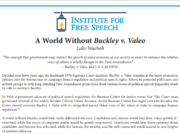Vox.com’s “40 charts that explain money in politics” fails miserably at, well, explaining money in politics. The charts seem to be less an explanation and more unproven innuendo about why money is supposedly ruining American democracy. What the collection of charts does do, however, is provide a window into some of the common misconceptions about campaign donations, campaign donors, and their supposed pernicious effects on elected officials. Here are 15 things that Vox should have mentioned to really explain money in politics.
Part I covers campaigns and donors. Check out Part II, which covers disclosure, independent groups, state-level campaign finance laws, and various other topics, here.
1) Political spending levels are not growing as fast as you think.
Vox Chart 1 is supposed to “drive home the most salient fact about money in politics: there’s more and more of it.” Unfortunately the chart is wrong. It is not true that the amount of money in politics has doubled from 2000 to 2012 – at least not by an honest calculation of spending. First, the Vox chart fails to account for inflation, a basic step in determining prices across time.[1] Below is the same chart as chart 1 in the Vox explainer, except the spending amounts shown have been adjusted for inflation.
So, instead of doubling, spending on “elections” and “lobbying” increased by 50% from 2000 to 2012. This is not an insignificant amount, but it is far less than Vox claims.
But wait; there’s more. According to the methodology of the Center for Responsive Politics (CRP), the organization that collected this data, “[b]reaking with tradition, the Center for Responsive politics has modified how it calculates the total cost of federal elections. That’s because the data provided by the FEC is now more detailed, allowing us to more carefully calculate the amount spent on election activities by PACs and candidates. The modified calculations affect only races from 2010 on.” In other words, the amount spent in the 2012 election takes into account certain types of spending that are not tracked in the 2000, 2002, 2004, 2006, and 2008 elections, and, therefore, are not counted.
How much spending is missed for these earlier elections? No one knows. CRP claims that, “we do not expect figures for those years would be radically different.” That may be true, but the point is that comparing this data across time is no longer an apples to apples comparison and spending in elections, while it has definitely increased, has not increased as dramatically as Vox claims because earlier spending has been omitted. This is the difference between counting the trees in the forest from the ground versus renting a helicopter to count from the sky – one gives you a much more complete picture, but does not necessarily mean the forest has grown.
Finally, as a nation, we are becoming richer. Just as inhabitants of a wealthy nation give more to charities, one would expect the amount of political donations to increase. And, in fact, that is the case. If you look at election spending as a percentage of GDP, the number is remarkably stable (the graph below is courtesy of The Atlantic.)
By this measure, more money was spent in 2012 than in 2000 or 1992, but it was less than what was spent in 1968 and 1932. And we still have a long way to go before we spend as much as a percentage of GDP as was spent in the 1896 battle between William McKinley and William Jennings Bryan.
2) Small donors give more money than you would expect.
In Chart 3, Vox would have you believe that small donors are underrepresented in terms of political donations.
It claims Obama raised “only” 28 percent and Romney “merely” 12 percent from small donors. But this is a trick of statistics and actually should be viewed as a fairly significant block of contributions. Imagine, for example, that 1,000 individuals gave $10 and 1,000 contributors gave $1,000 (the Vox definition of a big money donor). What percentage of the total funds came from small donors? Less than 1 percent! In fact, the reason small donors give such a large percentage of the campaign funding is because they are far more numerous than large donors. It is a tautology to say that small donors give less money – that is why they are small donors – and it is misleading to suggest that these values are somehow unexpectedly low. In fact, it has been reasonably argued that President Obama’s fundraising success, in particular, is attributable to small donors.
Now, if you foolishly believe the purpose of all campaign donations is to “buy” politicians, then it is true that more money comes from larger donations (because big numbers are larger than small numbers, even in politics), but …
3) Individuals give to candidates they already agree with.
Chart 4 of the Vox piece purports to tell the reader about how polarized big money donors are. The not-so-subtle conclusion is that money is helping to make our politics more extreme. Vox’s definition of polarization, however, is whether a donor gives to both Republicans and Democrats (and if they do, whether they give to those two groups equally). The ideal moderate donor in this scenario gives $1000 to Democrats for every $1000 to Republicans.
That contributors donate their money to only one party should be unsurprising. You similarly don’t find many individuals who are fans of both the Yankees and the Red Sox. And, for those who are worried about the undue influence of “money in politics,” this should be heralded as great news. If money really did buy influence, then an individual that wanted said influence would not care whether the last name of the politician he was attempting to “buy” was followed by a D or an R; you would expect this graph to be a bell curve or at the very least a straight line. In reality, donors are not buying influence; they are giving to candidates that already share their political positions. This, again, is basic common sense. If you think more environmental regulations are needed, you are going to support candidates that agree with you – you are not going to attempt to “buy off” the opposition and simultaneously support your preferred candidate.
 So, are wealthy donors actually more radical then small donors? A graph of small donor polarization is notably lacking from the Vox piece, so allow me to supplement with these two charts (courtesy of The Washington Post’s Monkey Cage blog).
So, are wealthy donors actually more radical then small donors? A graph of small donor polarization is notably lacking from the Vox piece, so allow me to supplement with these two charts (courtesy of The Washington Post’s Monkey Cage blog).
In actuality, larger contributors are less polarized than smaller contributors. This chart looks not at multi-party donations, but at how close a particular politician is to the political center and where donations flow. As is clear, small donors tend to give more heavily to more extreme candidates and large donors tend to give to establishment and moderate candidates.
In fact, the group that receives the least money from large donors is the far right. Unfortunately, a quick glance at the Vox chart without understanding their unusual measurement of polarization might lead you to the exact opposite conclusion.
4) Large donations are not buying votes.
Vox Chart 5 enhances this narrative about extremely wealthy GOP donors (Chart 6 examines the wealthy contributors to Democrats). Chart 5 examines how much the wealthiest individual campaign contributors gave in 2012. It is undeniably true that casino magnate Sheldon Adelson and his wife Miriam Adelson donated a tremendous amount of money (over $92 million) to political causes in the election cycle, almost quadrupling the next biggest individual spender, the late Harold Simmons.
But what the chart fails to illustrate and the article addresses with a single throw-away parenthetical is how remarkably ineffective all of that money was. Of the $92 million spent by the Adelsons, $20 million was spent supporting organizations advocating for Newt Gingrich in his failed primary bid. After Gingrich lost, $30 million was given to groups supporting Mitt Romney in his failed presidential bid. Thus, over half of the Adelsons’ spending went to PACs or Super PACs supporting failed presidential candidates. The money simply did not translate into votes.
Lest you think the other $42 million the Adelsons donated toward down-ballot races was more effective, think again. $4 million was spent in an unsuccessful attempt to stop the Senate bid of Virginia’s Tim Kaine; $1 million failed to defeat Michigan Senator Debbie Stabenow; $2 million supported the failed Florida congressional campaign of Connie Mack; $750,000 opposing Florida congressman Pat Murphy had no effect; and $500,000 supported the fruitless Senate primary campaign of Texas Lieutenant Governor David Dewhurst. Not to mention the $23 Million given to Karl Rove’s American Crossroads Super PAC, which was successful in helping to elect just two of the twelve candidates the group supported.
Sheldon Adelson appears to have an almost singular gift for picking political losers. Those who worry about the allegedly pervasive impact of money in politics should be celebrating the spending of the Adelsons. Voters were neither bought nor convinced by the ads that this “outside money” purchased, and instead made democratic decisions based on their preferences, not the preference of the few Sheldon Adelsons of the world.
5) The candidate that spends more usually wins, but not because of the larger spending.
Sheldon Adelson aside, it is true that the candidate that raises and spends more money usually wins their election. But, as even Vox admits (in Chart 11), “the causality isn’t entirely clear.” That is a bit of an understatement. The academic research goes further, “[w]orking with existing estimates and applying them to current data suggests that increments to spending have negligible effects on vote shares in competitive House races.” In non-academy speak, that means that when you control for the large intrinsic leg-up offered by incumbency and the fact that winners are more popular with voters (and therefore more likely to be popular with donors), the benefit of outspending your opponent is negligible.
This conclusion is further supported by the remarkable lack of success of very wealthy, self-funded candidates. The campaign funds of self-financed millionaires – like Carly Fiorina, Linda McMahon, Ross Perot, and Meg Whitman – are independent of actual voter support, and these candidates have demonstrated that no amount of money can buy electoral success.
Stay tuned for Part II …
[1] It is possible that both the Vox chart and the original OpenSecrets data that produced it do account for inflation. If so, however, it is not mentioned in OpenSecrets’ methodology that describes how they aggregated these data for each election.














